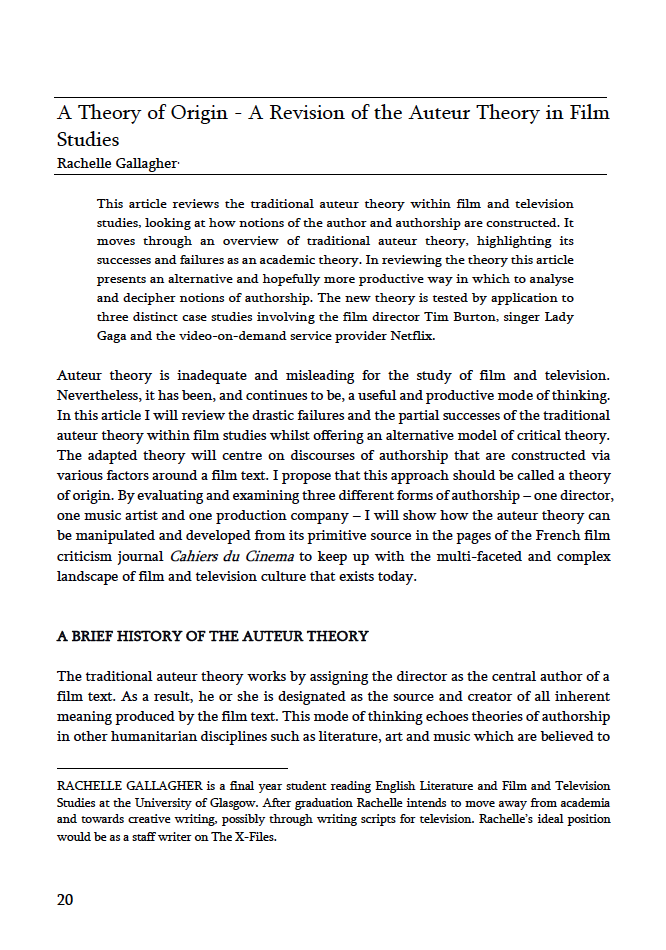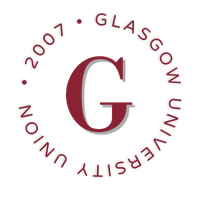A Theory of Origin
A Revision of the Auteur Theory in Film Studies
DOI:
https://doi.org/10.36399/GroundingsUG.9.195Keywords:
Auteur, Auteur Theory, Author, Authorship, Critical Review, Tim Burton, Lady Gaga, NetflixAbstract
This article reviews the traditional auteur theory within film and television studies, looking at how notions of the author and authorship are constructed. It moves through an overview of traditional auteur theory, highlighting its successes and failures as an academic theory. In reviewing the theory this article presents an alternative and hopefully more productive way in which to analyse and decipher notions of authorship. The new theory is tested by application to three distinct case studies involving the film director Tim Burton, singer Lady Gaga and the video-on-demand service provider Netflix.
References
D. Bordwell, Making Meaning: Inference and Rhetoric in the Interpretation of Cinema (Cambridge, MA: Harvard University Press, 1989).
Lady Gaga, (2011) 'Born This Way', Track 2 from the album Born This Way. Written by Stefani Germanotta and Jeppe Laursen. Produced by Stefani Germanotta, Jeppe Laursen, Fernando Garibay and Paul Blair (California: Interscope Records).
Lady Gaga, (2011) 'Dance in the Dark', Track 5 from the album The Fame Monster. Written by Stefani Germanotta and Fernando Garibay. Produced by Fernando Garibay, co-produced by Stefani Germanotta (California: Interscope Records).
J. Jack Halbestram, ‘Gaga Feminism: Sex, Gender and the End of Normal’ (Boston: Beacon Press, 2012).
Matt Hills, The Works of Tim Burton; From Margins to Mainstream. (ed.) Jeffrey Andrew Weinstock. (Basingstoke: Palgrave Macmillan, 2013).
Pauline Kael, ‘Circles and Squares’, (1963) 16:3 Film Quarterly, 12-26.
Derrit Mason, ‘The Trouble with Going Gaga’ c(2013) 4:1 Reviews in Cultural Theory, 19-24.
Alison McMahan, The Film of Tim Burton: Animating live action in contemporary Hollywood (New York/London: Continuum: 2005).
Helmut Merschmann, (trans. Michael Kane) Tim Burton: The Life and Films of a Visionary Director (London: Titan Books, 2000).
Karen Petruska, ‘Content That Travels: International Content and Original Programming on U.S. Streaming Sites’ in Flow Online Journal (Austin: University of Texas, 2015). Available at: http://www.flowjournal.org/2015/04/content-that-travels-international/.
Mark Salisbury, (ed.) Burton on Burton. Revised edition (London: Faber and Faber: 2008).
Andrew Sarris, The American cinema: Directors and Directions 1929-1968 (New York: Dutton, 1968).
Janet Staiger, ‘Authorship Approaches’ in Authorship and Film. (eds.) David A. Gerstner and Janet Staiger (New York: Routledge, 2003), 27–57.
Adam Sorice, ‘“The girl who lives behind the aura’: A Dissertation on Lady Gaga”’(2014) published in a series of blogposts. Available at: https://adamsorice.wordpress.com/2014/01/14/gaga-dissertation/ .
W. K. Wimsatt, ‘Genesis: A Fallacy Revisited,’ in The Disciplines of Criticism. (eds.) Peter Demeu, Thomas Greene, and Lowry Nelson, Jr. (New Haven, CT: Yale University Press, 1968).

Published
Issue
Section
License
Copyright (c) 2016 Rachelle Gallagher

This work is licensed under a Creative Commons Attribution 4.0 International License.
The CC BY 4.0 license is a Creative Commons license. This is a non-copyleft free license that is good for art and entertainment works, and educational works. It is compatible with all versions of the GNU GPL; however, like all CC licenses, it should not be used on software. People are free to: Share — copy and redistribute the material in any medium or format; Adapt — remix, transform, and build upon the material for any purpose, even commercially. The licensor cannot revoke these freedoms as long as you follow the license terms. But they must conform to the following terms: Attribution — You must give appropriate credit, provide a link to the license, and indicate if changes were made. You may do so in any reasonable manner, but not in any way that suggests the licensor endorses you or your use. No additional restrictions — You may not apply legal terms or technological measures that legally restrict others from doing anything the license permits.
Please check individual article PDF copies to see if any additional restrictions apply.







